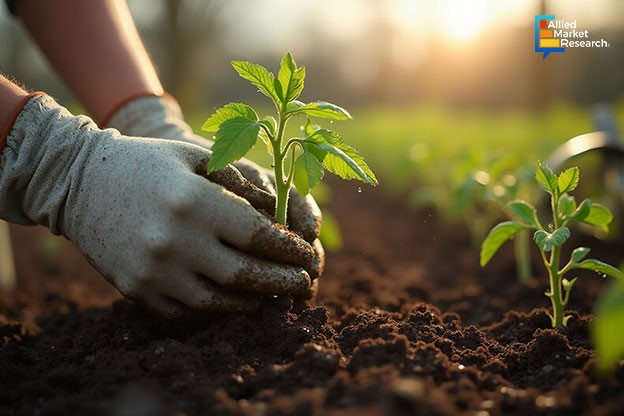Greenhouse Soil: An Essential Raw Material for a Profitable Horticulture Business

7 Apr
2025
Key takeaways:
- Introduction
- Applications of greenhouse soils
- Impact of the expanding horticulture sector on the industry
A greenhouse is an artificially built structure designed for cultivating plants under controlled environmental conditions and parameters like temperature and humidity. The idea of greenhouses has become popular as it provides extended cropping and growing seasons which are necessary for certain types of plants. For instance, in polar regions, the climate is extremely cold for most of the year and the time window for growing different plants is very short. In such a scenario, greenhouses offer a solution to enhancing the overall quantity, quality, and variety of the produce, thus increasing the profitability of the cultivator in the long run. Apart from this, the protection from pests and diseases offered by these structures makes them ideal for growing plants that are quite vulnerable to normal outdoor conditions. Like most other agricultural inputs used inside a greenhouse, soils, too, are specifically prepared to improve the quantity and quality of the yield.
Increasing utility of greenhouse soils opening new avenues for growth
Typically, vegetable crops, fruits, and flowering plants are grown in greenhouses as they are highly vulnerable to pests, diseases, and harsh weather conditions like hail, wind, rain, and extreme temperatures. These plants take up huge amounts of nutrients from the soil leading to a rapid reduction in soil fertility with each cropping season. In normal conditions, these soils get enough time for regeneration as each cultivation cycle is followed by a period of fallowing, wherein arable land is purposefully kept unseeded to increase the fertility and water storage capacity of the soil. However, since greenhouses opt for extended cropping seasons, a specialized soil culture is necessary to provide nutrition to plants throughout the year.
According to several leading agricultural experts, a loamy soil mixture with around 15–20% of well-decomposed organic matter, aged for six months or more, is ideal for greenhouse cultivation.. Moreover, research studies have shown that calcareous and alkaline soils reduce levels of micronutrients like iron, zinc, manganese and copper, thereby stunting the growth of the plant in the long run. Hence, various research studies have shown that greenhouse soils with a slightly acidic pH are ideal for crop cultivation in these controlled conditions.
Increased investments in horticulture creating new growth opportunities for the industry
In the post-pandemic period, the awareness regarding the importance of healthy lifestyles and balanced diets has increased significantly leading to the growth in consumption of nutritious food items such as vegetables, pulses, and fruits. Many leading farmer-producer organizations and multinational food companies have started constructing large greenhouses to cater to this huge surge in demand for different cereals, grains, and horticulture products. This has increased the use of greenhouse soils exponentially, driving the growth of the industry in recent times.
Along with this, the launch of novel products by various agriculture companies has helped the greenhouse soil industry gather a revenue of $8.3 billion by 2033. The market accounted for $4.5 billion in 2023 and is predicted to rise at a CAGR of 6.4% during 2024-2033. For example, in June 2024, Sun Gro Horticulture, a leading peat moss and bark-based growing mixes supplier, unveiled a Sunshine Black Bear, a climate-conscious potting mix for sustainable gardening and horticulture activities. Developed using carbon-rich biochar, this solution helps soil improve its carbon capture capabilities, thus reducing the emissions caused by greenhouse cultivation.
To sum it up, the unique conditions present inside a greenhouse necessitate the use of specialized soil cultures that provide adequate nutrition to plants during extended cropping seasons. Moreover, the rising demand for horticulture food products has played an important role in the growth of the industry. In addition, the launch of innovative products by different companies is anticipated to strengthen the position of the market in the near future.
Contact our experts for tips and recommendations on how to capitalize on the opportunities offered by the industry!

Akhilesh Prabhugaonkar
Author's Bio- Akhilesh Prabhugaonkar holds a bachelor’s degree in Electronics Engineering from the reputed Vishwakarma Institute of Technology. He has a special interest in the fields of forensics, world history, international relations and foreign policy, sports, agriculture, astronomy, security, and oceanography. An ardent bibliophile and melophile, Akhilesh loves to write on topics of his interest and various other societal issues. This love for writing made him enter the professional world of content writing and pursue his career in this direction.
Meat Processing Equipment: Integration of Automation and AI Creating Profitable Opportunities
Avenue: Entire Library membership of Allied Market Research Reports at your disposal
- Avenue is an innovative subscription-based online report database.
- Avail an online access to the entire library of syndicated reports on more than 2,000 niche industries and company profiles on more than 12,000 firms across 11 domains.
- A cost-effective model tailored for entrepreneurs, investors, and students & researchers at universities.
- Request customizations, suggest new reports, and avail analyst support as per your requirements.
- Get an access to the library of reports at any time from any device and anywhere.
Related Post
-
How are Submarine Cables Transforming Global Connectivity with Enhanced User Experience?
-
Endoscopy Procedures: Transformations in Techniques and Applications
-
AI-Powered Video Analytics: How the Product Actually Works for enterprises
-
Painting Robots: Transforming Precision Coating and Creative Applications
-
Innovations in Pharmacovigilance Systems Advancing Patient Safety
-
Understanding Edge Security: Keeping Data Safe Near the Source
-
Exploring the Use and Advancements of 3D Laser Scanners in Professional Applications
-
Reinforcing Industrial Controls with Smarter Tools and Training








